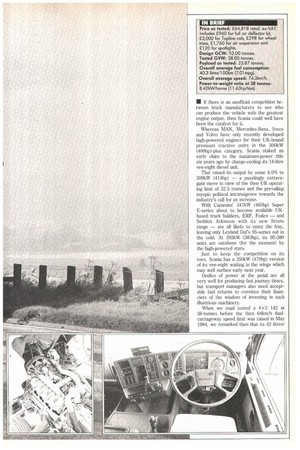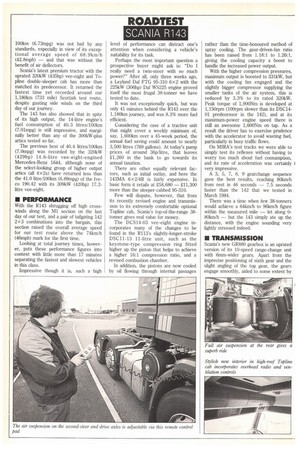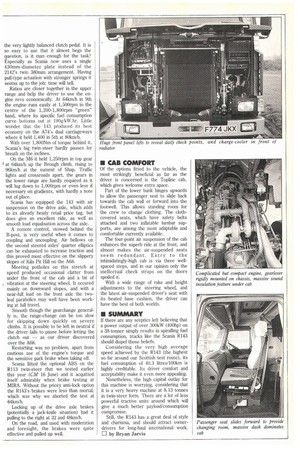• If there is an unofficial competition between truck manufacturers
Page 75

Page 76

Page 77

If you've noticed an error in this article please click here to report it so we can fix it.
to see who can produce the vehicle with the greatest engine output, then Scalia could well have been the catalyst for it.
Whereas MAN, Mercedes-Benz, Iveco and Volvo have only recently developed high-powered engines for their UK-bound premium tractive units in the 300kW (400hp)-plus category, Scania staked an early claim to the maximum-power title six years ago by charge-cooling its 14-litre vee-eight diesel unit.
That raised its output by some 4.0% to 309kW (414hp) — a puzzlingly extravagant move in view of the then UK operating limit of 32.5 tonnes and the prevailing myopic political intransigence towards the industry's call for an increase.
With Cummins' 347kW (465hp) Super E-series about to become available UKbased truck builders, ERF, Foden — and Seddon Atkinson with its new Strato range — are all likely to enter the fray, leaving only Leyland Oaf's 95-series out in the cold. At 282kW (383hp), its 95-380 units are outshone (for the moment) by the high-powered stars.
Just to keep the competition on its toes, Scania has a 350kW (470hp) version of its vee-eight waiting in the wings which may well surface early next year.
Oodles of power at the pedal are all very well for producing fast journey times, but transport managers also need acceptable fuel returns to convince their financiers of the wisdom of investing in such illustrious machinery.
When we road tested a 4x2 142 at 38-tonnes before the then 64km/h dualcarriageway speed limit was raised in May 1984, we remarked then that its 42 litres/ 100km (6.73mpg) was not bad by any standards, especially in view of its exceptional average speed of 68.9km/h (42.8mph) — and that was without the benefit of air deflectors.
Scania's latest premium tractor with the uprated 320kW (435hp) vee-eight and Topline double-sleeper cab has more than matched its predecessor. It returned the fastest time yet recorded around our 1,180km (733 mile) Scottish test route, despite gusting side winds on the third day of our journey.
The 143 has also showed that in spite of its high output, the 14-litre engine's fuel consumption of 40.3 litres/100km (7.01mpg) is still impressive, and marginally better than any of the 300kW-plus artics tested so far.
The previous best of 40.4 litres/100km (7.0mpg) was recorded by the 320kW (429hp) 14.6-litre vee-eight-engined Mercedes-Benz 1644, although none of the select-looking group of higher output artics (all 4x2s) have returned less than the 41.0 litre/100km (6.89mpg) of the lyeco 190.42 with its 309kW (420hp) 17.2litre vee-eight.
• PERFORMANCE
With the R143 shrugging off high crosswinds along the M1 section on the last day of our test, and a pair of tailgating 142 2+3 combinations into the bargain, this section raised the overall average speed for our test route above the 741un/h (46mph) mark for the first time.
Looking at total journey times, however, puts these performance figures into context with little more than 17 minutes separating the fastest and slowest vehicles in this class.
Impressive though it is, such a high level of performance can distract one's attention when considering a vehicle's suitability for its task.
Perhaps the most important question a prospective buyer might ask is: "Do I really need a twin-steer with so much power?" After all, only three weeks ago, a Leyland Daf FTG 95-310 6x2 with the 225kW (306hp) Daf WS225 engine proved itself the most frugal 38-tonner we have tested to date.
It was not exceptionally quick, but was only 41 minutes behind the R143 over the 1,180km journey, and was 8.3% more fuel efficient, Considering the case of a tractive unit that might cover a weekly minimum of, say, 1,600km over a 45-week period, the annual fuel saving could amount to nearly 3,500 litres (769 gallons). At today's pump prices of around 36p/litre, that leaves 21,260 in the bank to go towards its annual taxation.
There are other equally relevant factors, such as initial outlay, and here the 143MA 6x2/4R is fairly expensive. In basic form it retails at 258,680 — .211,300 more than the sleeper-cabbed 95-310.
Few will dispute, however, that from its recently revised engine and transmission to its extremely comfortable optional Topline cab, Scania's top-of-the-range 38tonner gives real value for money.
The DCS14-03 vee-eight engine incorporates many of the changes to be found in the R113's slightly-longer-stroke DSC11-13 11-litre unit, such as the keystone-type compression ring fitted higher up the piston that helps to achieve a higher 16:1 compression ratio, and a revised combustion chamber.
In addition, the pistons are now cooled by oil flowing through internal passages rather than the time-honoured method of spray cooling. The gear-driven-fan ratio has been raised from 1.18:1 to 1.26:1, giving the cooling capacity a boost to handle the increased power output.
With the higher compression pressures, maximum output is boosted to 331kW, but with the cooling fan engaged and the slightly bigger compressor supplying the smaller tanks of the air system, this is reduced by 3.3% to its rated 320kW. Peak torque of 1,900Nm is developed at 1,150rpm (100rpm slower than its DSC1401 predecessor in the 142), and at its maximum-power engine speed there is still an awesome 1,600Nm on tap. As a result the driver has to exercise prudence with the accelerator to avoid wasting fuel, particularly in busy traffic flows.
On MIRA's test tracks we were able to simply test its reflexes without having to worry too much about fuel consumption, and its rate of acceleration was certainly I very impressive.
A 3, 5, 7, 8, 9 gearchange sequence gave the best results, reaching 80km/h from rest in 46 seconds — 7.5 seconds faster than the 142 that we tested in March 1984.
There was a time when few 38-tonners would achieve a 64Iun/h to 961urn/h figure within the measured mile — let along 080Iun/h — but the 143 simply ate up the distance, with the engine sounding very lightly stressed indeed.
• TRANSMISSION
Scania's new GR880 gearbox is an uprated version of its 10-speed range-change unit with 6mm-wider gears. Apart from the imprecise positioning of sixth gear and the slight angling of the top gear, the gears engage smoothly, aided to some extent by the very lightly balanced clutch pedal. It is so easy to use that it almost begs the question, is it man enough for the task?
Especially as Scania now uses a single 430mm-diameter plate instead of the 2142's twin 380nun arrangement. Having pull-type actuation with stronger springs it seems up to the job: time will tell.
Ratios are closer together in the upper range and help the driver to use the en gine revs economically. At 64km/h in 9th the engine runs easily at 1,500rpm in the centre of the 1,200-1,800rpm "green" band, where its specific fuel consumption curve bottoms out at 190g/kW.hr. Little wonder that the 143 produced its best economy on the A74's dual carriageways where it held 1,400 in 5th at 801cm/h.
With over 1,800Nm of torque behind it, Scania's big twin-steer hardly pauses for breath on the inclines.
On the M6 it held 1,250rpm in top gear I at 641un/h up the Brough climb, rising to 961un/h at the summit of Shap. Traffic lights and crossroads apart, the gears in the lower range are hardly required as it will lug down to 1,000rpm or even less if necessary on gradients, with hardly a note out of place.
Scania has equipped the 143 with air suspension on the drive axle, which adds to its already heady retail price tag, but does give an excellent ride, as well as smooth load equalisation across the axle.
A remote control, stowed behind the B-post, is very useful when it comes to coupling and uncoupling. Air bellows on the second steered axles' quarter elliptics can be exhausted to increase traction and this proved most effective on the slippery slopes of Kiln Pit Hill on the A68.
Meeting potholes on this stretch at speed produced occasional clatter from under the front of the cab and a bit of 1 vibration at the steering wheel. It occured mainly on downward slopes, and with a near-full load on the front axle the twoleaf parabolics may well have been working at full travel.
Smooth though the gearchange generally is, the range-change can be too slow for skipping down quickly on severe climbs. It is possible to be left in neutral if the driver fails to pause before letting the clutch out — as our driver discovered over the A68.
Restarting was no problem, apart from cautious use of the engine's torque and the sensitive park brake when taking off.
Scania fitted the optional ABS on the R113 twin-steer that we tested earlier this year (CM 16 June) and it acquitted itself admirably when brake testing at MIRA. Without the pricey anti-lock option the R143's brakes were less than mortal, which was why we aborted the test at 64km/h.
Locking up of the drive axle brakes (potentially a jack-knife situation) had it pulling to the right at 32 and 48km/h.
On the road, and used with moderation and foresight, the brakes were quite effective and pulled up well.
• CAB COMFORT
Of the options fitted to the vehicle, the most strikingly beneficial as far as the driver is concerned is the Topline cab, which gives welcome extra space.
Part of the lower bunk hinges upwards to allow the passenger seat to slide back towards the cab wall or forward into the footwell. This allows standing room for the crew to change clothing. The dothcovered seats, which have safety belts attached and two inflatable lumbar supports, are among the most adaptable and comfortable currently available.
The four-point air suspension of the cab enhances the superb ride at the front, and almost makes the air-suspended seats seem redundant. Entry to the intimidatingly-high cab is via three wellspaced steps, and in our opinion only the ineffectual check straps on the doors spoiled it.
With a wide range of rake and height adjustments to the steering wheel, and the latest air-suspended driver's seat with its heated base cushion, the driver can have the best of both worlds.
• SUMMARY
If there are any sceptics left believing that a power output of over 300kW (400hp) on a 38-tonner simply results in spiralling fuel consumption, trucks like the Scania R143 should dispel those beliefs.
Considering the very high average speed achieved by the R143 (the highest so far around our Scottish test route), its fuel consumption of 40.3 litres/100km is highly creditable. Its driver comfort and acceptability make it even more appealing.
Nonetheless, the high capital outlay for this machine is worrying, considering that it is a very heavy machine at 8.13 tonnes in twin-steer form. `Mere are a lot of less powerful tractive units around which will give a much better payload/consumption compromise.
Still, the R143 has a great deal of style and charisma, and should attract ownerdrivers for long-haul international work. by Bryan Jarvis










































































































